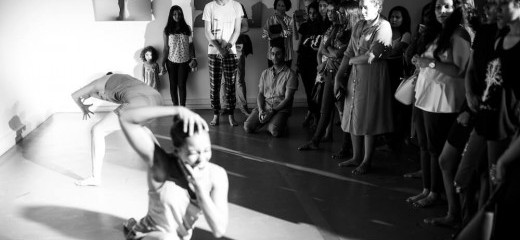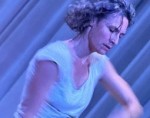
Dancing the Self In-Between*: A Dialogue with Umeshi Rajeendra
by Rhonda Moore
Dancers fervently stroke the full length of their arms with their hands and undulate their torsos with a rhythmic, sea-like fluidity, then suddenly thrust their arms outward, alternately receiving, shedding, accepting, and rejecting. The writhing bodies all gather to huddle, seeking community, and then scatter to the far reaches of the space--not as a means of escape, but as an expression of resolute preparedness. It seems that we are privy to a conversation between opposing forces, as gentle and sharp movements push, pull, and stretch in every direction. The dancers ricochet themselves throughout the parameter of the room, using the weight of their bodies to propel themselves through space. They are fleeting arrows that arrive only to be propelled again, over and over, in a game of transitory presence that fills the air with a sense of infinite impermanence and continual shifting.
The opening passage is my description of one of Umeshi Rajeendra’s dance works. Umeshi Rajeendra is a multi-ethnic movement artist of Sinhalese and Tamil origins. She was born into a civil war which erupted between these two populations in Sri Lanka (formerly Ceylon). This conflict was rooted in ethnic tension, making it complex, and arose in large part because of Sri Lanka's colonial history. Rajeendra describes the household in which she grew up as one that acknowledged, accepted, and even celebrated multiple identities. This offers a stark contrast to a larger, global society that not only uses cultural difference to establish imaginary boundaries, but to also uphold colonial-based systems that work to erase the presence of black and brown people. As part of the thINKing DANCE 's Decolonizing Dance Writing series, I spent time interviewing Rajeendra in efforts to unpack how decolonization shows up in her artistic work. Much like her socialization as both a Sinhalese and Tamil artist, and much like the dance I describe, Rajeendra’s movement practice, “self in-between” has “decolonizing” implications, relying on a discourse that buttresses acceptance and non-acceptance, favored and unfavored, recognition and non-recognition, belonging, and otherness.
“As a multi-ethnic and cultural being growing up in war, I have been straddling this ‘other’ position, a position I refer to as ‘in-between’, all my life. I felt this more strongly when I was dancing, and ‘in-between’ is where I feel most at home; it is an active state of refusal for me, towards binaries, that I do not belong or want to belong in, solely because I am a product of many things. And so, the ‘self in-between’ is about finding one’s place at the nexus of multiplicity, a confluence of dialogues taking place in tandem, where not only the so-called binaries could meet, clash, blur and/or dislocate, but also where the confused and disorientated are legitimate modes of inquiry, activating elements that are intersecting with one another constantly. To practice the ‘self in-between’ is a way of finding knowledge about the body and the world through dance/movement, a practice as a process of research in and through the body.”
The preceding quote is an excerpt from Rajeendra’s description about her “self in-between'' movement practice. For me, words like amalgam and mosaic come to mind when I consider “self in-between'' as Rajeendra’s way of approaching and moving through all the cultural information contained in her body, including the conscious and unconscious sense-memories attached to her corporeal repository. This modality of cultural remembrance is consonant with the African cultural retention evidenced by the diasporic black experience. The configurations, shapes, and rhythms present in her work sing with urgent desire to make her presence known, inside-out. Closely-grouped dancers execute semaphoric gestures while advancing across the stage, morphing then to erratic, staccato, percussive movements of the torso as if guided by forces beyond their control. The dancers do nothing to hide the presence of conflict and resistance; pressing, pulling, twisting, entering and exiting states of physical contortion. They freely shift between multiple sensibilities, taking us through changing landscapes as they widen into the space and then return to the fold in yet a different close formation, as if to refuel and prepare. The repetition in the movement calls us to action while searching motifs pervade.
Rajeendra’s proclivity to shift among the Sinhala, Tamil, and English languages is a clear reflection of her refusal to rely upon any one idiom to express her thoughts. Her willful resistance to being categorized emerges from the translation of the “self in-between.” There is no single word for the term Rajeendra’s has created in either Sinhala or Tamil, her native tongues. The combination of words Rajeendra chooses imply both a straddling and a confluence of ideas.
Sinhala: අතර මැද - spoken “atara maeda” or “in the middle”
Tamil: இடையில் – spoken as “ Idaiyil” or “between”
The conditions of Rajeendra’s and my exchange offer a useful paradigm. The nine and a half hour time difference between Philadelphia, Pennsylvania (my location) and Colombo, Sri Lanka (her location) makes my today her yesterday, and Umeshi’s now is my tomorrow. I am living in her past and she is guiding me towards my future. Across continents, we ourselves are in relationship with the “in-betweenness” of time. Rajeendra’s “self in-between” emerges from a central theme of fluidity and constant motion. Yet, unlike life events that connect us with others over multiple time zones, “self in-between” designates a conscious recognition of the multiple selves present in each single body, especially those that reside in the bodies of unconsidered peoples. “Self in-between” dialogues with the mind-body space in each of us, a place where exploration, interrogation, understanding, utilization, and acceptance of all the cultural knowledge the body contains are possible. The controlling forces of coloniality blankets a laissez-faire on whom and what is deemed familiar, normal, and rectified. As people of color, as the unsung, as the ‘non-normal’, it is only in this internal space to which Rajeendra refers that we are allowed to embrace the multiplicity of the full self without being penalized by outside judgement.
According to Rajeendra, “self in-between'' has no specific address. It is a place where all that one is and all that one is not can be considered. The “self in-between'' is not an invitation to choose one’s identity but rather, an opportunity to live within shifting realities. It is a place where one can discover a myriad of references to the self. It focuses on discovering the full palette of every individual from deep within, where the somatic knowledge of cultural and ancestral identity resides. I describe the “self in-between'' as a reclamation and resuscitation of the histories, sensations, thoughts, and presence of the disenfranchised, for centuries disdained, reconfigured, and ultimately ignored across continents. The “self in-between” is a stomping ground for resistance, where the full multiplicity of humanity can be considered, and therefore a palpable manifestation of decoloniality at work. It is a space of in-betweenness in thought and action, a process of interaction with forces in continual flux between agreement and conflict, comfort and discomfort, weakness and strength, movement, and stillness. Rajeendra’s “self in-between” seeks to identify and then unravel/travel through portals leading to the full spectrum of thought and movement all humanity potentially contains.
So why distinguish decolonization from decoloniality? Why does it matter? As I consider the suffixes attached to the root of these words, I can glean Rajeendra’s dissatisfaction with decolonization. The suffix ‘tion’ is linked to action, process and result, all ideas linked with processes of beginning, middle and end. Decoloniality—and here the suffix ‘ity’ implies state, condition, or quality—has an undeniable sense of perpetuity. Decoloniality, then, can be perceived as a more active practice than fait accompli. It is a continual confronting and unlinking from Eurocentrism, and is the term Rajeendra prefers to use when describing both her thought processes and movement practice. While decolonization embraces a similar reclamation of self, the very formation of the word implies something much larger, and moreover implying conclusion. Umeshi Rajeendra sees her work as a never-ending, continuous exploration of mind and body. She is interested in reading between the lines. If we can accept and embrace all that we personally house, we open ourselves to the possibility of cognitively empathetic exchange of ideas around difference, acceptance, presence, and erasure.
The fact that Rajeendra perceives her daily walk through life as an on-going practice of decoloniality is startlingly refreshing, and something many of us either overlook, perhaps even belittle. I think the following excerpt from our dialog underscores how her work is an undeniable healing force in the field.
“I access and activate decoloniality through all my daily interactions. Intentional decoloniality is embedded in the way I speak to others, the way I physically present myself when I walk into a room. I do not consider myself as always getting it right, and the potential for contradictions, uncertainties and failures are prevalent. It is recognizable in my conscious efforts to acknowledge others on the horizontal and not vertical plane, deliberately noticing all the diversity around me. These are the ways we reclaim and rebuild the humanity we were all meant to embrace; this is how I resist. Without this fundamental premise, I cannot do the work I’ve accepted as my life’s purpose.”
Admittedly, I am left hopeful that even the tiniest of gestures, delivered with intentionality, can become arrows of change.
By Rhonda Moore
September 3, 2021










